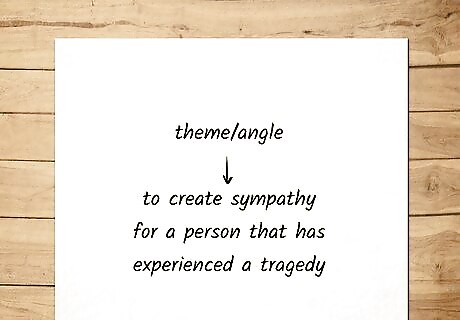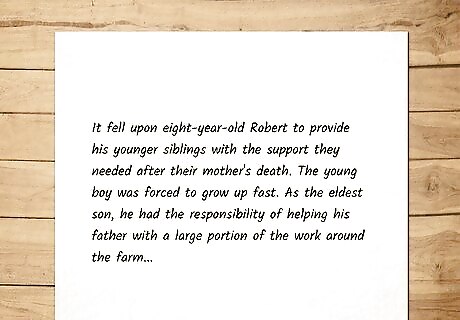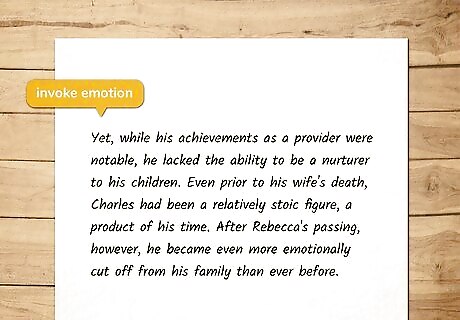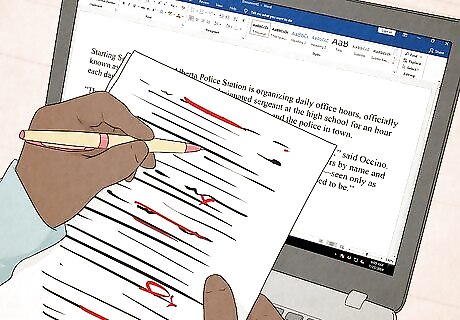
views
- Human interest stories use both facts and emotional language to tell the story of a person (or group of people) and elicit empathy from readers.
- Examples of a human interest story could include an uplifting story about kids raising money for charity, or the true tale of a pet saving their owner.
- Research your chosen subject carefully and interview your subjects. Craft an article with a catchy lead, an engaging story, and vivid descriptions.
What is a human interest story?

Human interest stories give emotional glimpses into a person’s life. Simply put, a human interest story is a type of feature article that tells someone's story through vivid detail, quotes, and emotional language rather than relying only on hard facts. They differ from news stories because they highlight the human experience, telling tales of people’s journeys, tragedies, and triumphs. A compelling human interest story could follow the journey of a refugee family fleeing their old lives and navigating a new future together. You could tell the tale of a record-breaking mountain climber who recently scaled one of the world’s highest peaks, sharing details about their early life, training, and future goals too. You might consider writing an exposé about a local politician who just got some major reforms passed that they promised during their campaign.

Human interest stories evoke empathy and motivation from readers. These features always have an intended purpose, whether the goal is to educate others, encourage activism, spark anger, or draw sympathy from readers. The goal of a human interest story isn’t just to inform; it’s designed to be thought-provoking and engaging by helping readers connect emotionally to the story. If you wrote about a refugee family, for example, your goal might be to educate readers. Some find this subject controversial, so you could write a story to evoke empathy and acceptance. If you were writing about a brave, remarkable mountain climber, your intent could simply be raising awareness and appreciation for the remarkable protagonist of your story. If you wrote the political exposé, your focus might be helping inspiring people into action—like grassroots campaigning or vocally supporting certain legislation.
Gathering Material for Your Story

Choose a story that appeals to you personally. While a traditional news story focuses on hard facts and data, a human interest story focuses on individual people or events and the emotion tied to them. As you look for a topic, choose something that you’re passionate about. You’ll most likely give your article your all if you pick a subject that truly excites you. A human interest article’s subject could be a particular person, an animal, or the story of an event or organization and the people involved with it. For example, if you love dogs, you could tell the story of a dog that got lost, survived on their own, and eventually found their owners again. If you’re passionate about mental health awareness, you could write about a community member who educates others about mental health issues.

Determine the theme and angle of your human interest story. Any good human interest story should have a focus, which is the story you’re trying to tell. Identify what you aim to accomplish by writing the piece. These stories can be used to support a cause, change opinions on a topic, or bring attention to an important topic that hasn't received enough attention. For example, your angle for a piece might be to create sympathy for a person that has experienced a tragedy. Alternatively, you might want to bring attention to a local hero’s good deeds. There might be an organization that is often viewed incorrectly, and you hope to shift perceptions of it.

Identify useful background information. Background information provides you with crucial elements of your story: who was involved and when each event occurred. It can also give the reader a broader scope of why your story matters! Research using a wide variety of trustworthy sources, including credible websites and books, authenticate each source before using it. Websites that end with “.org,” “.edu,” or “.gov” are often more credible than those that end with “.com” or other common suffixes. Research authors and judge their credibility based on their expertise level. Evaluate each online source for signs of a bias or reasons to believe the content is inaccurate. Remain objective throughout your research. Don’t make assumptions about a story; let research determine the facts and not your perception of things.

Interview your sources and get permission to quote them. Establish a rapport with your interviewee by treating them respectfully and finding commonalities between you. This will put them at ease and help them open up to you! Be direct and ask relevant open-ended questions that will allow your interviewee to give a detailed response (and give you the most information). Ask questions that begin with “what,” “why,” “when,” and “where.” Learn as much as you can and record your interviewee with an audio or video device—but get permission before using the device! Consider interviewing more than one person for your story; that will give you more information to work with. Take photos relevant to the story if it’s appropriate to do so. Sometimes your subject might request not to be photographed, but if they allow it, include a few photos of them.
Structuring the Human Interest Piece

Craft a catchy, concise headline and lead that describes the story. A lead, also known as the introduction, is what will convince readers to stick around and read the whole piece. Write a memorable headline to grab readers’ attention and then transition smoothly into the rest of the lead. Summarize your story briefly and give readers an idea of what they can expect from the rest of the piece. Consider starting with a brief story about the person you’re writing about. You could describe how an interviewee greeted you or played with their pet before the interview, for example. You could begin a piece about the dangers of the drought in Southern California by telling a short story about someone who fights wildfires. Introductions are typically 1 paragraph long, though your lead can be a maximum of 2 paragraphs for a human interest piece.

Include all information, quotes, opinions, and details in the body text. Once you set the scene, it’s time to tell readers the story from beginning to end. Give them the relevant information you researched and the emotional story elements that’ll grab their attention. Don’t worry about writing an inverted pyramid-style story; human interest articles should feel more like prose than news. Be concise! If you have a lot of different interviews and statements you can quote, limit your own word count as much as you can. Be mindful of the number of quotes you include. You don’t need to write the interviewee’s every word in your article—just the most relevant and interesting quotes.

Write a brief nut graf. A “nut graf” explains why you interviewed the person whose quotes are featured in your article. Introduce them to your readers and offer additional insight into their credibility, experience, and the reasons why their perspective is relevant to the piece. The nut graf helps readers understand what the interviewee has accomplished and why it matters. For example, if you interviewed a teacher to write about insufficient salaries for educators, explain who that teacher is, what they teach, their background, and their experience with the problem at hand. In a traditional news story, the nut graf is usually the 2nd paragraph. In your human interest piece, however, place it wherever you plan to start quoting the interviewee.

Summarize the story and link all its elements in the conclusion. Now that your story is told, wrap everything up for the reader. Write a summary that describes how the subject of your article has affected the world or why their actions matter. If your subject is a person, discuss their future plans on a personal level, including hopes, dreams, and fears. For example, you could write a conclusion explaining that the local activist you interviewed plans to run for a political position in the next few years and detailing exactly what they hope to change in office. Consider making the final sentence of your article a particularly poignant quote that emphasizes the story's message.
Writing a Compelling Story

Write in the present tense and second or third point of view. Human interest stories tend to be most effective when written in the present tense because it helps readers feel like they’re right in the moment as they read. When choosing a point of view, third-person is the most commonly-used POV for articles, but writing in second-person could really help your article stand out. Present-tense means describing something like it’s happening in the moment. For example, write, “Alex is tired, but she keeps going,” rather than, “Alex was tired, but she kept going.” Second-person point of view makes the reader part of the story using “You…” statements, while third-person relays information using pronouns like “He,” “She,” or “They.” Avoid first-person POV. First-person means writing in “I…” statements and a human interest story isn’t about you—it’s about someone else!

Describe people, places, events, and time in detail. Use descriptive language to transport your readers to the scene you’re writing about. Your research offers plenty of insight into the situation, so rely on that research to help you write thorough descriptions. Include enough detail to create a vibrant image in readers’ minds so they can picture the entire scene without seeing it themselves. Instead of saying, "The sun is setting," try, "The setting sun paints the sky with red and orange hues." Describe a person with words like, “Her angular features are offset by soft, wavy hair, and she has piercing brown eyes….” Be creative with your word choice. Sprinkle in vivid language, alliteration, or a clever pun if you think of one. It's okay to be more poetic than what you’d see in a standard news story. Think of all the fiction stories you’ve read. How did those authors introduce characters? Your story can still use that level of prose even if it isn't fiction.

Write with clear, straightforward words that are accessible to all readers. Technical jargon can be difficult to understand for readers who don’t know much about your chosen subject matter. Avoid using words that are too specific to a single group of people—and if you do have to use technical or specific words (which can happen), explain them clearly the first time you bring them up. A military story might require the use of ranks, but some ranks are difficult to understand. In the Navy, for instance, "Hospital Man 1” is a senior rank to "Hospital Man 2," but that isn’t obvious to outsiders. Relate difficult terms to everyday things. Instead of citing "Hospital Man 1" as the head of a unit in the Navy, use terms like "supervisor" if the main character in your story works below them.

Use emotional and informal language to set the mood of the article. Create a tone in your piece by building emotion throughout the lead and body that culminates in the conclusion. Because human interest stories are intended to convey feelings as much as information, they allow for terms that help establish the tone in the reader's mind. Include anecdotes and quotes to give your article life and let them carry the piece. You can even write quotes like dialogue, as long as you’re still directly quoting the interviewee. If you write the tragic story of a man who lost his wife, for example, you could describe their happiness together, the events that separated them, and finally, the emotional fallout he experienced after the loss.

Maintain your journalistic integrity and report the facts of the story. Resist the urge to embellish facts! Emotional language is expected in a human interest piece, but your writing should still reflect the story as truthfully as possible. Strike a balance between the emotional angle of the piece and the cold, hard facts that should also be included. Altering your account of events or facts makes the whole story less credible. You can express an opinion, use emotional language, and be compelling without changing the facts!

Proofread and edit your writing. The final step to writing a good human interest story (before submission) is proofreading and editing it. Step away from your article and take some time to clear your mind, then return to it with fresh eyes. Check over the article for spelling and grammatical errors, as well as consistency in the tone and emotions of the story. Fact-check your story to ensure you haven’t included incorrect information. Think about the story's focus and the emotions you identified earlier. Did you convey them the way you intended? You could revise the piece if you feel a different delivery will impact readers more.




















Comments
0 comment